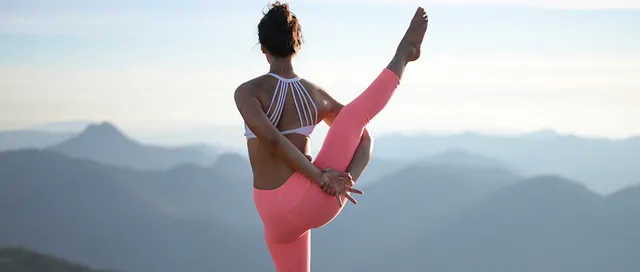
SVARGA DVIJASANA
This week is dedicated to SVARGA DVIJASANA, the bird of paradise.
It's an intense but progressive streak.
This balanced posture strengthens and relaxes the muscles of the legs, opens the hips and relaxes the shoulders. It opens the rib cage while straightening the spine, thereby promoting respiratory amplitude.
In order to find balance, the supporting leg on the ground must be active and the weight of the body well distributed in the four corners of the foot (ball of the big toe, outside of the heel, ball of the little toe and inside of the heel, internal arch of the foot straightened). The ground leg should be contracted but while remaining flexible behind the knee especially for hyperlaxes, the foot should push back against the ground so as not to collapse downwards but to find upward energy.
This posture is not wide apart but is closer to a very large Utthita Trikonasana, hence its benefits of softening the back thighs, stretching the psoas of the leg from the ground and creating an opening in the hips. Hamstrings and soft psoas soften the hips and groins, lengthen the lower back and relieve back pain, and also aid digestion.
The tonicity of the center of the body is fundamental from the entry of the posture until its exit to protect the back, especially the lumbar area.
Holding the hands in Chin Mudra is also a great help in maintaining balance in the posture. Mudra means "seal" in Sanskrit. It is also translated as "sign" or "attitude". The Chin Mudra represents the unification of the soul. The thumb is the symbol of harmony and awareness. The index finger is the soul of the practitioner and the other three fingers are the three gunas, the quality of energy (Tamas, Rajas, Satva). By closing the circle with the index finger and thumb, the yogi achieves the union of the human soul with the soul of the Universe. The Chin Mudra which evokes the spiritual consciousness, makes it possible to drive out the negative to make room for the yogic consciousness, it is recognized for its benefits on the physical and the mental. This hand gesture amplifies the benefits of posture by improving the fluidity of the digestive system and soothing its disorders, it helps to better manage behavioral disorders, fight anger and stress and improve memory.
This balanced posture strengthens and softens the muscles of the legs, opens the hips and softens the shoulders. It opens the rib cage while straightening the spine, thus promoting respiratory amplitude. The grip of the hands is in Chin Mudra which represents the unification of the soul.
SUKHASANA (R / L)
- song of OM
- lean far forward, fingertips on the ground
➞ walk fingers to one side and bring the navel above the thigh (R / L)
|| MALASANA Beginners: mat rolled under the heels
- hands in Namaste + straight back
- walk the fingertips far forward
TADASANA
SURYA NAMASKARA (R / L)
- BHUJANGASANA / AMS / LOW LUNT in GOMUKHASANA arm, strap (if R leg in front then L elbow in the sky)
➞ HIGH LUNT in GOMUKHASANA arm Beginners: stay in low lunge
- BHUJANGASANA / AMS / LOW LUNT in Paschima Namaskar Beginners: catching opposing elbows
TADASANA
VIRABHADRASANA II (R / L)
➞ UTTHITA PARSVAKONASANA, outside hand / foot Beginners: hand / brick
➞ UTTHITA TRIKONASANA, widely spaced feet, flat hand Beginners: hand / brick
➞ UTTHITA PARSVAKONASANAinside,hand / foot Beginners: hand / brick
Access the annotated class sequence with posture images and join the community of teachers!